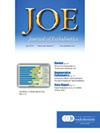Effect of Different Methods of Heating Sodium Hypochlorite Irrigating Solution on the External Root Surface Temperature
IF 3.6
2区 医学
Q1 DENTISTRY, ORAL SURGERY & MEDICINE
引用次数: 0
Abstract
Introduction
The aim of this study was to examine the temperature changes on the external root surface across coronal, middle, and apical root thirds upon intracanal and extracanal heating of 5.25% NaOCl.
Methods
Seventeen mandibular premolar teeth were trimmed to a length of 20 mm and prepared up to the X3 file of the Protaper Next rotary system. To measure temperatures on different thirds of the external root surface, 3 thermocouples were positioned outside the root. Irrigation was performed by heating the irrigation solution with different methods (room temperature, preheated to 50 °C, intracanal heating at 180 °C for 8 seconds). Temperature changes occurring on different root thirds were recorded and subjected to statistical analysis.
Results
Using the irrigation solution, either extracanal or intracanal heated, resulted in a significant increase in root surface temperatures compared to using at room temperature (P < .05). In intracanal heating group, coronal and middle thirds showed significant increase in root surface temperatures compared to apical third (P < .05). However, in extracanal heating and room temperature groups, coronal third showed significant increase in root surface temperatures compared to middle and apical thirds (P < .05). None of the applications caused a temperature change on the root surface exceeding 10 °C.
Conclusions
Heating of irrigation solution, either extracanal or intracanal, can significantly increase the temperature of the external root surface across its different thirds. Temperatures transmitted outside the root were considered safe for periodontal tissues.
次氯酸钠灌洗液不同加热方式对根外表面温度的影响。
本研究的目的是观察5.25% NaOCl在管内和外管内加热时,冠状根、中根和根尖三分之一的外根表面温度的变化。方法:将17颗下颌前磨牙修剪至20mm长度,准备至Protaper Next旋转系统的X3锉。为了测量根外表面不同三分之一的温度,在根外放置了三个热电偶。用不同的方法加热冲洗液(室温,预热至50℃,180℃管内加热8秒)进行冲洗。记录不同根三分之一的温度变化,并进行统计分析。结果:与室温下使用相比,使用肛管外或管内加热的灌洗液导致根表面温度显著升高(P < 0.05)。管内加热组冠状面和中三分之一根表面温度显著高于根尖三分之一(P < 0.05)。然而,在管外加热和室温组,冠状三分之一的根表面温度显著高于中、根尖三分之一(P < 0.05)。没有一种处理导致根表面温度变化超过10℃。结论:肛管外或肛管内灌洗液加热均可显著提高外根表面不同三分之一的温度。根外传递的温度被认为对牙周组织是安全的。
本文章由计算机程序翻译,如有差异,请以英文原文为准。
求助全文
约1分钟内获得全文
求助全文
来源期刊

Journal of endodontics
医学-牙科与口腔外科
CiteScore
8.80
自引率
9.50%
发文量
224
审稿时长
42 days
期刊介绍:
The Journal of Endodontics, the official journal of the American Association of Endodontists, publishes scientific articles, case reports and comparison studies evaluating materials and methods of pulp conservation and endodontic treatment. Endodontists and general dentists can learn about new concepts in root canal treatment and the latest advances in techniques and instrumentation in the one journal that helps them keep pace with rapid changes in this field.
 求助内容:
求助内容: 应助结果提醒方式:
应助结果提醒方式:


